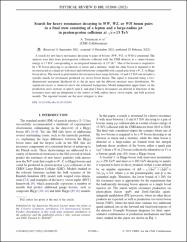Search for heavy resonances decaying to WW, WZ, or WH boson pairs in a final state consisting of a lepton and a large-radius jet in proton-proton collisions at root s=13 TeV
Citation
Tumasyan, A., Adam, W., Andrejkovic, J. W., Bergauer, T., Chatterjee, S., Dragicevic, M., ... & Yuan, L. (2022). Search for heavy resonances decaying to W W, W Z, or W H boson pairs in a final state consisting of a lepton and a large-radius jet in proton-proton collisions at s= 13 TeV. Physical Review D, 105(3), 032008, p.Abstract
A search for new heavy resonances decaying to pairs of bosons (WW, WZ, or WH) is presented. The analysis uses data from proton-proton collisions collected with the CMS detector at a center-of-mass energy of 13 TeV, corresponding to an integrated luminosity of 137 fb(-1). One of the bosons is required to be a W boson decaying to an electron or muon and a neutrino, while the other boson is required to be reconstructed as a single jet with mass and substructure compatible with a quark pair from a W, Z, or Higgs boson decay. The search is performed in the resonance mass range between 1.0 and 4.5 TeVand includes a specific search for resonances produced via vector boson fusion. The signal is extracted using a twodimensional maximum likelihood fit to the jet mass and the diboson invariant mass distributions. No significant excess is observed above the estimated background. Model-independent upper limits on the production cross sections of spin-0, spin-1, and spin-2 heavy resonances are derived as functions of the resonance mass and are interpreted in the context of bulk radion, heavy vector triplet, and bulk graviton models. The reported bounds are the most stringent to date.

















